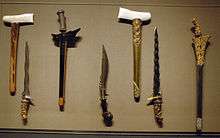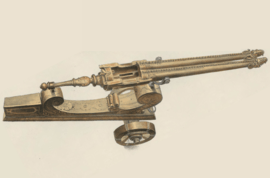Pisau raut
Pisau raut (pisau meaning 'knife'; raut meaning 'rattan') is a Dayak whittling-knife that serves as a tool to prepare the rattan found in the island of Kalimantan in Indonesia. It is placed in the same sheath as the mandau, the traditional weapon of the Dayak people. Despite being placed in the same scabbard sheath as the weapon mandau, the pisau raut is mostly used as a crafting tool.
| Pisau raut | |
|---|---|
 A pisau raut from Kalimantan, Indonesia, pre-1890. | |
| Type | Whittling knife |
| Place of origin | Kalimantan, Indonesia |
| Service history | |
| Used by | Dayak people, Orang Asli, Malay (ethnic group) |
| Specifications | |
| Length | 7.5cm to 12.5cm |
| Blade type | Single edge, chisel grind |
| Hilt type | Antler/deer horn, wood |
| Scabbard/sheath | Jomok (Artocarpus elasticus) bark or bamboo (Dayak style) |
Description
_MET_36.25.729_003june2014.jpg)
_MET_36.25.803_002june2014.jpg)
Pisau raut is found throughout the Island of Kalimantan of Indonesia. It is variously known under different names by different Dayak tribes: munbat for the Iban tribe, langgei for the Ngaju, jabang for the Dayak of Baranjan, etc. The Dayak pisau raut is used for harvesting and processing rattan as well as a tool to carve wood. Even though the pisau raut is placed in the same sheath as the weapon mandau, pisau raut was not a weapon.[1]
Pisau raut consists of a small blade and a wooden handle. The blade is about 10 centimetres (3.9 in) long and is slightly curved. The blade is attached to a wooden hilt that is about three times longer than the blade itself. The blade is attached to the hilt by gluing the blade onto the wooden hilt using a kind of dammar resin taken from the damar tree and then bound with rattan cords. In other version, the blade is convex on one side and concave on the other, which is similar to the design of the Dayak mandau, a much larger blade.[2]
The hilt of the pisau raut is much longer than the blade, reaching 30 centimetres (12 in) to 40 centimetres (16 in) long. It is also slightly curved, following the same curve as the blade. This wooden handle is often decorated with finely carved inlaid bands made of the horn of a water buffalo or a stag. At the end of the handle is a knob which is also made of a horn of a stag, or sometimes of light-colored bone or ivory, giving it a contrast with the normally dark-colored hilt. The knob is intricately decorated with figurative representations of mythical creatures typical of Dayak art, e.g. a stylised aso dragon head above a crouching figure.[2]
Pisau raut is used by holding the blade between thumb and index finger. The very long hilt is held tight between the ribs and lower arms, or under the armpit. The pisau raut is used with the strength of the body while at the same time used to work on fine details.[3]
On Kalimantan, the pisau raut is carried with the mandau in a separate scabbard. The scabbard used for the pisau raut is made of palm leaf and attached to the back of the scabbard for the mandau.[3]
References
- Stone 2013, p. 503.
- van Zonneveld 2001, p. 108.
- van Zonneveld 2001, p. 109.
Cited works
- Stone, George Cameron (2013). A Glossary of the Construction, Decoration and Use of Arms and Armor: in All Countries and in All Times. Dover: Courier Corporation. ISBN 9780486131290.CS1 maint: ref=harv (link)
- van Zonneveld, Albert G. (2001). Traditional Weapons of the Indonesian Archipelago. C. Zwartenkot Art Books. ISBN 9789054500049.CS1 maint: ref=harv (link)


